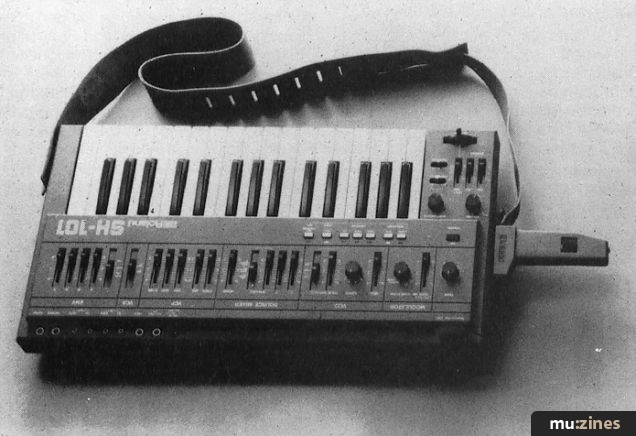Magazine Archive
Home -> Magazines -> Issues -> Articles in this issue -> View
Article Group: | |
Moog Source | |
Two oscillator 16 memory programmable mono with arpeggiator and sequencerArticle from One Two Testing, November 1982 | |

Quite a few Moog experiments on this one; not least of them is the colour. During the first few months of its life it's been described as distinctly "Dennis Fischer" or a ceramic hob.
Apart from the yellow, orange, blue and chrome colour scheme, this also marks Moog's first serious step into digital technology — not in the oscillators but in the memories and controls.
It's a 16 memory programmable mono synth, meant to replace the Minimoog which has been discontinued. There's only one control on the front, but it's unlike any other you may have seen.
It's called an Incrementor — a large free running knob spinning in either direction which is accompanied by an LED readout. The front panel comprises a series of touch sensitive switches invisible underneath the matt surface. If you want to alter the filter attack time, touch the appropriate yellow pad and that converts the Incrementor into an attack time control.
No attack appears as 0 in the readout, full registers as 99. The same trick applies to all the other would-be controls though for footages, waveforms and so on a simple on/off switch is all that's needed.
Two reasons for this: first it's cheaper — fewer potentiometers and wires to worry about — and secondly it makes memory programming easier. Another advantage of such circuitry is that it can be neatly sidetracked into becoming a sequencer and Moog haven't missed the opportunity — two 44 note sequences and one 24 note arpeggio can be stored in the machine's second level, each of the 16 program buttons having a double life as record, play, cassette load, etc.
Yes, it does have a cassette filing system to build libraries of sounds, and you can verify if you've got a good "take" before wiping the memories clean.
What they haven't taken away are the comfortable feeling pitch and modulation wheels in the left-hand corner. Instead there's a bonus of two octave selection buttons — standard and an octave up.
The keyboard is lovely, very fast and light, all the voices are easy to change and the Incrementor control is simple to use. The programmes are always in permanent edit so you can update any setting by pressing the undercover switch (the LED lights showing the present value in the memory) and shifting the control.
The Incrementor glides easily, so one spin in the appropriate direction takes it from 0 to 99. The memories are accurate, recording the finest detail such as the difference between the oscillators being perfectly in tune or just a fraction out providing a slow, warm beat, though the LED isn't always so accurate in its readings.
The sequencer has some unusual features such as being able to record a different sound for every note, if you need it. The LED also acts as an early warning when you're loading in a sequence. It counts down the number of spaces left in the memory.

However, the method of getting at it isn't so easy. The 16 switches for the memories each have secret identities. Every one has a second level that controls sequencer functions or special effects. Jumping between the first and second levels is time consuming and confusing, and apparently Moog are looking at a way of getting round this in future models.
The arpeggiator doesn't work by holding down a chord, as on the Pro One, but by playing it in note by note which leaves you free to start high, slot in a low bit then go back to the top again. It's like a second sequencer, but in step time, each note having the same timing and duration as the last.
Incidentally, the Source's full sequencer isn't worried by note length. Hold down an A for 30 seconds and it will be played back for 30 seconds and still only take one space in the memory.
The sound is obviously Moog. Big, rounded, with a sweet filter and a powerful bass end, but I can't help feeling the designers haven't got as much out of the machine as they might have done. There are features such as an LFO and a pulse width setting on the oscillators, but they can't be linked together.
The sample and hold exists only as a special effect in the second level so it can't be programmed into the memories.
The 16 instant recall memories are a fabulous boon for live work and that's where the Source's main advantage lies. Otherwise there are rival machines on the market that make more noises for less money.
£945
Also featuring gear in this article
A Selective Survey of Lead Line Synthesizers
(ES Sep 83)
Moog Source and Moog Rogue
(EMM May 82)
Source Of Inspiration
(MT May 89)
Patchwork
(EMM Jul 84)
Browse category: Synthesizer > Moog
Publisher: One Two Testing - IPC Magazines Ltd, Northern & Shell Ltd.
The current copyright owner/s of this content may differ from the originally published copyright notice.
More details on copyright ownership...
Synth Special
Review
Help Support The Things You Love
mu:zines is the result of thousands of hours of effort, and will require many thousands more going forward to reach our goals of getting all this content online.
If you value this resource, you can support this project - it really helps!
Donations for September 2025
Issues donated this month: 0
New issues that have been donated or scanned for us this month.
Funds donated this month: £0.00
All donations and support are gratefully appreciated - thank you.
Magazines Needed - Can You Help?
Do you have any of these magazine issues?
If so, and you can donate, lend or scan them to help complete our archive, please get in touch via the Contribute page - thanks!






